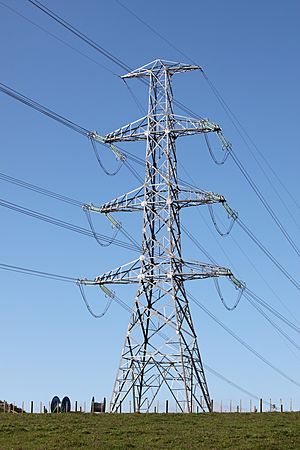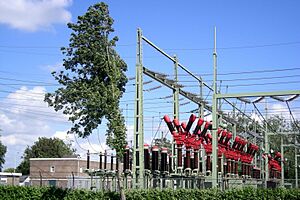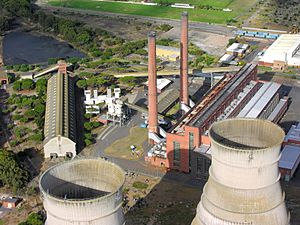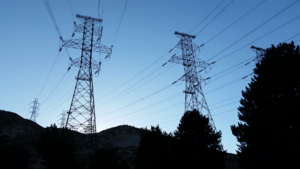Electric power industry facts for kids
The electric power industry is all about getting electric power to people and businesses. This includes making electricity, sending it over long distances, distributing it to homes, and finally selling it.
The idea of selling electricity started in 1882. Back then, it was mainly used for electric lighting. In the 1880s and 1890s, people became more worried about safety and costs. This led to rules being made for the industry.
Electricity used to be very expensive and only available in big cities. But now, it's a super important part of how modern countries work.
By the mid-1900s, many people thought that only a few big companies should handle electricity. They believed this was the most efficient way. In some places, one company did everything from making electricity to selling it. Governments would then watch over these companies to make sure prices were fair.
Since the 1990s, many areas have changed this system. They have separated the parts that make electricity from the parts that distribute it. This can make things more competitive and efficient. However, sending and distributing electricity is still tricky because it's hard to make a lot of money from it.
Contents
How Electricity Started
People knew how to make electricity from chemicals since Alessandro Volta made the voltaic pile in 1800. But this way of making electricity was (and still is) very expensive.
In 1831, Michael Faraday invented a machine that could make electricity from spinning. But it took almost 50 years for this technology to become useful for businesses.
In 1878, in the United States, Thomas Edison created a way to replace gas lighting with electricity. He made and sold systems that used direct current (DC) electricity, which was made and sent out locally.
In December 1881, Robert Hammond showed off the new electric light in Brighton, UK. It was a big success! Many shop owners wanted to use the new lights. So, the Hammond Electricity Supply Co. was started.
In early 1882, Edison opened the world's first power station that used steam. It was at Holborn Viaduct in London. He had an agreement to light the streets for three months. Soon, he was supplying electric light to many local customers. This system used direct current (DC).
Later in September 1882, Edison opened the Pearl Street Power Station in New York City. This also used DC power. Because Edison couldn't easily change the voltage of DC, power stations had to be very close to the customers, usually within a mile. This worked in city centers but was too expensive for suburbs.
The mid to late 1880s saw the rise of alternating current (AC) systems in Europe and the U.S. AC power had a big advantage: transformers. These devices could easily change the voltage. Power stations could make electricity at a low voltage, then use transformers to raise it very high for sending it over long distances. Then, at local substations, other transformers could lower the voltage for homes and businesses.
Increasing the voltage meant less current was needed to send the same amount of power. This made the wires thinner and reduced power loss. So, it became much cheaper to send power over long distances. Power plants (like hydroelectric ones) could be built far from cities.
AC and DC systems competed for a while in what was called the "war of the currents". DC was a bit safer, but AC's huge technical and economic benefits made it the winner.
The AC power system we use today grew quickly. Many inventors and business people helped, like George Westinghouse, Nikola Tesla, and others.
Power electronics is about using special electronic parts to control and change electric power. This field started in 1902 with the invention of the mercury arc rectifier, which changed AC into DC.
Later, in 1959, the MOSFET (metal-oxide-semiconductor field-effect transistor) was invented. This was a huge step forward! MOSFETs let engineers make power devices that were much better and smaller. Today, the power MOSFET is the most common power device in the world. It's popular because it's easy to use, switches quickly, and is very strong.
Even though high voltage direct current (HVDC) is now used more for sending huge amounts of electricity over very long distances, most electricity is still made, sent, and distributed using alternating current (AC).
How the Industry Works
The electric power industry is usually divided into four main parts:
- Making electricity (like at a power station)
- Sending electricity over long distances (transmission)
- Distributing electricity to local areas
- Selling electricity to customers
In many countries, one electric company owns everything. This is why electric power is often seen as a "natural monopoly". The industry is usually watched very closely by the government, which often sets prices. Sometimes, the government even owns and runs the companies. However, more recently, there's been a trend to let more companies compete, especially in the distribution and selling parts.
In countries where electricity is not fully controlled by the government, customers might even choose to buy more expensive "green electricity" from renewable sources.
Making Electricity
Making electricity means changing some other energy source into electric power that can be used on the power grid. Most electricity is made by spinning machines called "generators". These generators move wires through a magnetic field to create electric current.
A "prime mover" machine spins the generator. This is often a steam turbine, a gas turbine, or a water turbine. The energy sources for these machines are often fossil fuels (like coal, oil, or natural gas), nuclear fission, geothermal steam, or falling water (hydroelectric). Renewable sources like wind and solar energy are becoming more and more important.
Power plants must make just enough electricity to match what people are using at any moment. This means there must be enough power plants to meet the highest demand, especially during "peak" times. At the same time, the cheapest energy sources are usually used first.
Power plants have automatic controls to adjust how much power they send into the system. They constantly balance their output with how much electricity is being used. Managing a large power grid with many generators and thousands of users is a big challenge. It needs to be done in a way that is cheap, good for the environment, and reliable.
For example, nuclear power plants are cheap to run once built, so they often run all the time to meet the average "base load" of electricity. More expensive plants, like natural gas turbines, might only run for short times during the day to meet peak demands.
Sending Electricity (Transmission)
Electric power transmission is about moving large amounts of electricity from where it's made (like a power plant) to a local electrical substation. The connected lines that do this are called a transmission network. This is different from the local wires that go to customers' homes.
The combined transmission and distribution network is often called the "power grid". In the United Kingdom, India, and New Zealand, it's known as the National Grid.
A "wide area synchronous grid" connects many generators that make AC power at the same frequency with many customers. For example, in North America, there are four large interconnected grids. In Europe, one big grid connects most of the continent.
In the past, the same company owned both transmission and distribution lines. But since the 1990s, many countries have changed the rules. Now, the electricity transmission business is often separate from the distribution business.
Distributing Electricity
Electric power distribution is the last step in getting electricity to individual customers. Distribution substations connect to the transmission system. They use transformers to lower the high transmission voltage to a medium voltage (between 2 and 35 kV).
Primary distribution lines carry this medium voltage power to other distribution transformers located near customers. These transformers lower the voltage again to the level used by lights, machines, or home appliances. Often, one transformer supplies several customers through secondary distribution lines. Homes and businesses connect to these secondary lines. Very large customers might connect directly to the primary distribution level.
Selling Electricity
Electricity retailing is the final step where electricity is sold from the companies that make it to the people and businesses who use it.
Electricity Around the World
How a country's electricity system is set up depends on its economy. In some places, the government controls all parts of making, sending, and distributing electricity. Other places have private companies, city-owned companies, or companies owned by their customers. Sometimes, different companies handle each part of the system.
Not everyone in the world has access to grid electricity. In 2017, about 840 million people (mostly in Africa) did not have electricity. This was down from 1.2 billion in 2010.
Changes in the Market
The way electric companies do business has changed a lot over the years. This has shaped the electricity industry into what it is today. Big changes started in England and Wales in 1990.
United States Changes
From 1996 to 1999, the Federal Energy Regulatory Commission (FERC) made rules to open up the U.S. electricity market to new companies. They hoped that more competition would save customers billions of dollars and lead to new ideas.
These rules aimed to create a fully connected grid and a national power market. However, there were some problems, like the California energy crisis of 2000 and the Enron scandal. These events showed that competitive markets could be unfair if not watched carefully. Also, the Northeast blackout of 2003 showed how important it is to have both fair prices and strong reliability.
Other Countries' Changes
In some countries, companies that make electricity and companies that sell it trade electricity with each other, much like stocks or money. As rules become more relaxed, power companies are selling off their parts. The energy market is becoming more like the gas market, using future contracts and other financial deals.
Even international deals are happening. For example, the UK's National Grid plc, a large private electric company, bought several electric companies in New England for $3.2 billion. Between 1995 and 1997, seven of the 12 main electric companies in England and Wales were bought by U.S. energy companies.
At home, local electric and gas companies have joined together. They saw the benefits of working together, especially saving money by having one meter for both services. New technologies are also appearing in the competitive electricity markets. Examples include fuel cells (used in space), gas turbines (like those in jet aircraft), solar power systems, offshore wind farms, and digital communication advances that help monitor and send out power.
What's Next for Electricity?
People expect that the demand for electricity will keep growing. The Information Revolution (with computers and the internet) relies heavily on electric power. Other areas that will need more electricity include new technologies that only use electricity, improvements in heating and cooling, industrial processes, and transportation (like hybrid vehicles and locomotives).
See also
- AC power
- Distributed generation
- Emissions & Generation Resource Integrated Database
- Meter Point Administration Number, a unique UK supply number
- National Grid (disambiguation)
- North American Electric Reliability Corporation
- Rate Case
- Reddy Kilowatt, a U.S. electricity corporate logo
- Samuel Insull
|








